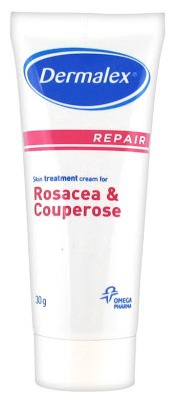
Repair Rosacea Dermatological Treatment
Highlights
Skim through
| Ingredient name | what-it-does | irr., com. | ID-Rating |
|---|---|---|---|
| Tri-Solve | |||
| Ethylhexyl Methoxycinnamate | sunscreen | 0, 0 | |
| Butyl Methoxydibenzoylmethane | sunscreen | goodie | |
| Bisabolol | soothing | goodie | |
| Esculin | |||
| Triticum Vulgare Germ Extract | goodie | ||
| Echinacea Angustifolia Extract | moisturizer/humectant, soothing | ||
| Boswellia Serrata Extract | soothing | ||
| Zanthoxylum Bungeanum Fruit Extract | |||
| Ci 42090 | colorant | ||
| Ci 19140 | colorant |
Dermalex Repair Rosacea Dermatological TreatmentIngredients explained
This ingredient name is not according to the INCI-standard. :( What, why?!
The trade name for an encapsulated ceramide product claimed to improve skin barrier function and thus help skin hydration. The proper INCI listing is the following: Ceramide NS (and) Trehalose (and) Cholesterol (and) Hydrogenated Lecithin
A clear, oil-soluble, "cosmetically-elegant" liquid that is the most commonly used chemical sunscreen. It absorbs UVB radiation (at wavelengths: 280-320 nm) with a peak protection at 310nm.
It only protects against UVB and not UVA rays (the 320-400 nm range) – so always choose products that contain other sunscreens too. It is not very stable either, when exposed to sunlight, it kind of breaks down and loses its effectiveness (not instantly, but over time - it loses 10% of its SPF protection ability within 35 mins). To make it more stable it can be - and should be - combined with other sunscreen agents to give stable and broad-spectrum protection (the new generation sunscreen agent, Tinosorb S is a particularly good one for that).
The famous Avobenzone. It is a special snowflake as it is the only globally available chemical sunscreen agent that provides proper UVA protection (in the US, new generation sunscreen agents are not approved because of impossible FDA regulations). It is the global gold standard of UVA protection and is the most used UVA sunscreen in the world.
It gives very good protection across the whole UVA range (310-400 nm that is both UVA1 and UVA2) with a peak protection at 360 nm. The problem with it, though, is that it is not photostable and degrades in the sunlight. Wikipedia says that avobenzone loses 36% of its UV-absorption capacity after just one hour of sunlight (yep, this is one of the reasons why sunscreens have to be reapplied after a few hours).
It's one of the active parts of Chamomile that contains about 30% of bisabolol. It's a clear oily fluid that is used in skincare as a nice anti-inflammatory and soothing ingredient.

It's a plant extract that comes from wheat germ. Used as skin- and hair conditioner and skin protectant.
Contains gluten, if you are allergic.

The extract coming from the Indian Frankincense, a medium-sized tree native to India. Mostly the gum-resin is used that is obtained from an incision made on the trunk of the tree. It contains about 30-60% resin, 5-10% fragrant essential oil, and the rest is made up of polysaccharides (mostly arabinose, galactose, xylose).
The biologically most active components of the resin are boswellic acids that have anti-inflammatory properties. According to manufacturer info, the boswellic acids rich resin extract is also a potent inhibitor of elastase (an enzyme that breaks down proteins, including collagen) and has antiGAGase activity (protecting the important natural moisturizing factors, glycosaminoglycans in the skin) meaning that it can help the skin to stay firm for a longer time.

CI 42090 or Blue 1 is a super common synthetic colorant in beauty & food. Used alone, it adds a brilliant smurf-like blue color, combined with Tartrazine, it gives the fifty shades of green.
Ci 19140 or Tartrazine is a super common colorant in skincare, makeup, medicine & food. It’s a synthetic lemon yellow that's used alone or mixed with other colors for special shades.
FDA says it's possible, but rare, to have an allergic-type reaction to a color additive. As an example, it mentions that Ci 19140 may cause itching and hives in some people but the colorant is always labeled so that you can avoid it if you are sensitive.
You may also want to take a look at...
| what‑it‑does | sunscreen |
| irritancy, com. | 0, 0 |
| what‑it‑does | sunscreen |
| what‑it‑does | soothing |
| what‑it‑does | moisturizer/humectant | soothing |
| what‑it‑does | soothing |
| what‑it‑does | colorant |
| what‑it‑does | colorant |





